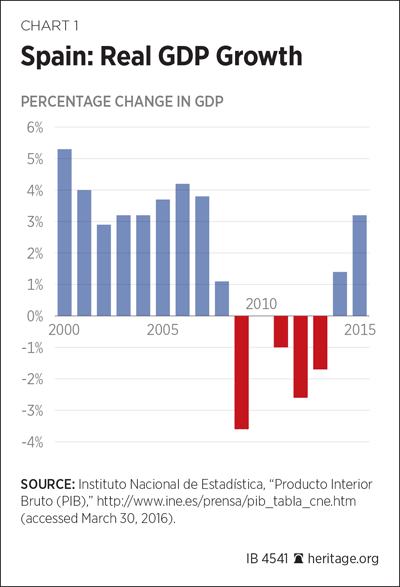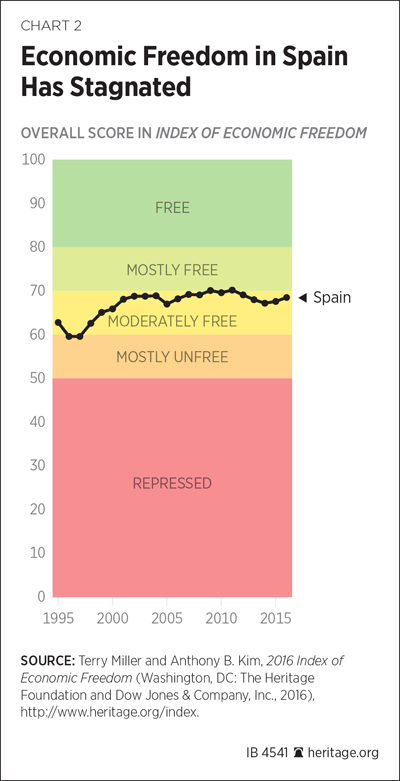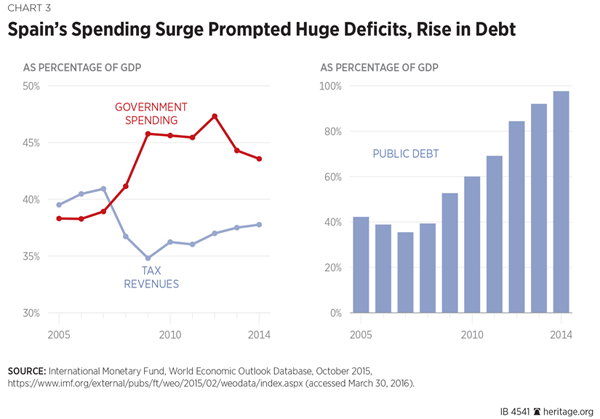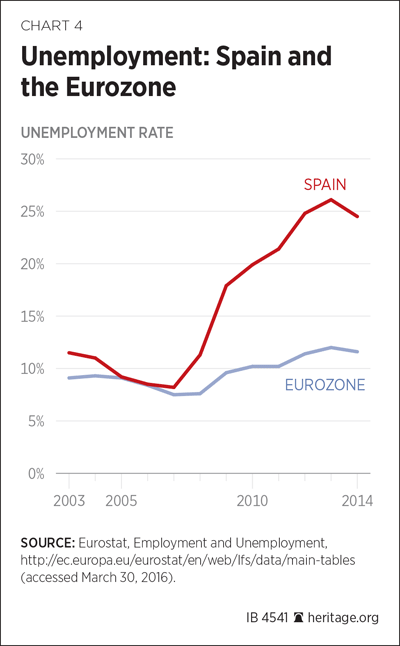After two decades of robust growth,[1] the 2008 financial crisis hit Spain hard. It exposed systemic institutional weaknesses and structural distortions in the economy that had not been addressed during the process of Spain’s incorporation into the European Union (EU). As in the United States and other countries, a credit boom in the early 2000s fuelled a real estate bubble that boosted demand, employment, and public revenues. Once the Great Recession began, the entire scheme came crashing down like the proverbial house of cards.
Since then, house prices have slowly reverted to historic norms, declining about 45 percent in real terms. Meanwhile, unemployment has jumped to untenable levels, peaking above 25 percent in 2012–2013. Public debt ballooned from 40 percent to 100 percent of gross domestic product (GDP) as a combined result of falling tax revenues, debt-financed deficit spending, and an overall lack of fiscal discipline in the public sector.
In addition, an EU banking system bailout totalled €41 billion in loans. Unlike private banks, which proved resilient despite significant stresses, Spain’s semi-public savings bank sector collapsed from almost 50 institutions to fewer than 10.
In the past four years, a number of structural adjustments have enhanced prospects for recovery. Economic freedom remains stagnant, however, and has yet to recover to pre-crisis levels.[2] For that to occur, further efforts are needed to free the economy and boost its competitiveness and dynamism.
Too Much Government Under Socialists and Conservatives
When former Prime Minister José Luis Rodríguez Zapatero and his Socialist Party (PSOE) took office in early 2008, they argued that Spain was not entering an economic crisis, although all macroeconomic indicators pointed to the contrary.[3] Eventually, the Zapatero government took action, but instead of tackling the country’s deteriorating fiscal situation, it turned to large stimulus spending measures that made matters worse.
In 2010, some limited austerity measures were introduced, including a 5 percent cut in the salaries of public workers and a freeze on state pensions. However, the bulk of Zapatero’s adjustment plan fell on the shoulders of taxpayers in the form of hikes in income taxes, the value-added tax (VAT), corporate taxes, and estate taxes.
Soon after Prime Minister Mariano Rajoy’s conservative Popular Party (PP) won an absolute majority in 2011, Rajoy’s cabinet launched a wide-ranging deficit-reduction plan combining surgical spending cuts with increases in direct and indirect taxes. Between 2010 and 2013, the Rajoy government approved 30 tax hikes. Just as the PSOE had done, the PP increased taxes almost across the board.[4] According to official government statistics, the combined impact of these tax hikes was €51 billion, or about 5 percent of Spain’s GDP—a significant drag on economic growth.[5]
The national government was joined by many regional governments that followed suit and raised taxes on 120 different occasions.[6] Also, local councils approved significant increases in municipal taxes, leading to a 40 percent increase in revenue raised.[7]
Fiscal reforms in 2014–2015 put some money back into taxpayer pockets, but total taxes still consume 38 percent of national income and fall disproportionately on a narrower tax base due to the ongoing unemployment crisis and large informal economy. The public sector still spends or manages about 44 percent of GDP.
With a budget deficit that was almost 6 percent of GDP in 2014, further fiscal consolidation is clearly necessary. Public debt is now close to 100 percent of GDP—more than €60,000 per worker—so the sooner Spain puts an end to its public deficits, the better. A key challenge will be to limit spending by regional governments.
The Populist Threat to Property Rights
In general, property rights are well protected in Spain, but in the past few years, some politicians have supported expropriation of bank-owned properties. More worryingly, property rights are threatened by the rise of Podemos, a populist, Communist party that gained 22 percent of the popular vote in December 2015. In its manifesto, Podemos calls not only for expropriation of bank assets, but also for possible nationalization of utility companies.
Also, corruption scandals continue to undercut respect for the rule of law. Political parties are popularly viewed as the institutions most affected by corruption in Spain, with campaign financing being a particular point of contention. This has damaged the electoral performance of the PP and the PSOE. Meanwhile, some leaders of Podemos have been caught up in scandals involving dirty money from Chavistas in Venezuela.[8]
Needed: A Less Rigid Labor Code and a Business-Friendlier Government
The main reason the unemployment rate exceeded 20 percent for three decades was the excessive rigidity of Spain’s labor law, which fostered an unequal system that protected some full-time jobs at the expense of part-time workers. Wage flexibility was constrained by collective bargaining, and termination costs were among the highest in Europe. The young suffered the most under this system, and unemployment rates exceeded 50 percent.
The Rajoy government injected more flexibility with its 2012 labor market reforms. The percentage of GDP subject to collective bargaining has declined significantly, wage adjustment has become easier to realize, and firing costs have diminished. One million new jobs have been created in the past two years, which should spur further reforms. Also, Spain has improved its position in the World Bank’s Doing Business rankings, rising from 39th in 2007 to 33rd in 2015.
Despite these improvements, however, more needs to be done. For example, cooperation must be enhanced among different administrative regions, especially the 17 Autonomous Communities that make different laws and may have different regulations. Some regions, such as Madrid, are quite business-friendly and should be emulated by the rest.
The Challenge for the Spanish Government
In order to achieve sustainable economic growth, Spain needs to limit government spending further at all levels, reform and lighten regulatory oversight, and reduce taxes. Also, more steps should be taken to tackle corruption and promote a much greater degree of labor flexibility. Continuing the difficult but necessary market-oriented reforms begun decades ago will bring more economic freedom to Spain.
—James M. Roberts is Research Fellow for Economic Freedom and Growth in the Center for Trade and Economics, of the Institute for Economic Freedom and Opportunity, at The Heritage Foundation. Diego Sánchez de la Cruz is the director of Civismo, a leading free-market think tank in Spain. He is also an associate professor at IE University as well as a political analyst in Spanish media.






